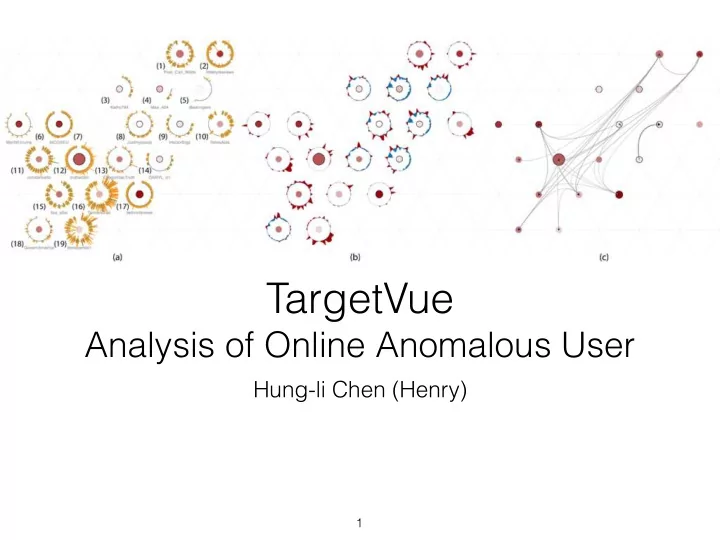

TargetVue Analysis of Online Anomalous User Hung-li Chen (Henry) 1
Target Vue: Visual Analysis of Anomalous User Behaviours in Online Communication Systems (TVCG, 2016) Nan Cao, Conglei Shi, Sabrina Lin, Jie Lu, Yu-Ru Lin, Ching-Yung Lin First five authors are from IBM T.J. Watson Research Centre The last author is from University of Pittsburgh not Pissburg… 2
Agenda • Context and Contribution • Requirements, Data and Tasks • Design of TargetVue • Evaluation and Comments 3
Agenda • Context and Contribution • Requirements, Data and Tasks • Design of TargetVue • Evaluation and Comments 4
Context • Anomaly Detection is important. • Challenging to find completely automated solutions Contribution • TargetVue: a system that detects and supports interactive exploration of anomalous users • New glyph design and the grid layout • Evaluation through a bot detection challenge and case a case study 5
Agenda • Context and Contribution • Requirements, Data and Tasks • Design of TargetVue • Evaluation and Comments 6
Data Model • Initiator - Social Objects - Responders • High-level features: Behaviour, Content, Interaction, Temporal, Network, User Profile • Data: time series of feature vectors (for each user) 7
Requirements 1. Feature Selection 2. Anomaly Detection in Context 3. Ranking Threats 4. Learn from User Feedback 8
Tasks • Showing the data overview and detection results • Interpreting user behaviours from different perspectives • Facilitate visual data comparisons • Revealing users’ impacts in social communication • Easy browsing of raw data • Flexible data labeling 9
Agenda • Context and Contribution • Requirements, Data and Tasks • Design of TargetVue • Evaluation and Comments 10
TargetVue: System Design Time Adaptive Local Outlier Factor Choosing Features 11
TargetVue: Interface Inspection Global View User List Messages Feature Variation Propagation 12
Global Encodings • Users as circular nodes • Importance as the size of the nodes • Sentiments or anomaly scores as color 13
Global View • Data: dimensionality reduced mean feature vector, kernel density estimation • Encoding: location, contour map (white to blue) • Task: overview • Outliers are in the low density areas 14
User list and Messages • Data: user profile information, raw messages • Encoding: high frequency tag cloud, list of messages and user profiles • Task: browsing raw data and overview 15
Feature Variation and Propagation View • Data: derived feature z-score (difference from baseline), users in communication threads • Encoding: temporal heatmap, propogation view (introduced in FluxFlow) • High impact users have many other users in the thread 16
Inspection: Behaviour Glyph • Data: posting and responding activity timeline, duration, number of users involved, sentiment of the threads • Encoding: circular timeline, line mark (see below) • line mark: thickness (number of users), length (duration), color (sentiment), intersection (time when the user join). 17
Inspection: Z-glyph • Data: derived z-score of different features, (based on mean and standard deviation of features) • Encoding: baseline circle, color coded area mark 18
Inspection: Relation glyph • Data: interaction relationships between users • Encoding: directed links 19
Inspection: Layout • Triangle mesh for placement • Fast linear layout • Preserve topology • Maximize average similarity (clustering) between neighbouring glyphs 20
Interaction Query Box Filter (range slider) Context Switch Zoom and Pan Select for Inspection Highlight Data Labeling 21
Agenda • Context and Contribution • Requirements, Data and Tasks • Design of TargetVue • Evaluation and Comments 22
Evaluation • The investigators used the system in social bot detection challenge. • Use global view to pick out outliers and anomalies • Inspect the users, and study their behaviour • Inspect specific features of users • Tune the model • Example usage on Email data. • Domain expert interview (2 experts): “Comprehensive”, “very powerful” 23
Comments • Delivers what are promised (Explicit reference to the requirements and tasks). • Glyph design is information dense, effective for identifying anomalies, encoding may not be the most visually effective. • Scaling limit is unclear (mentioned that the pipeline is built on hadoop, used the system for twitter data of 8000 users and 4M tweets) • Evaluation in the future would be helpful. 24
Questions? 25
Recommend
More recommend